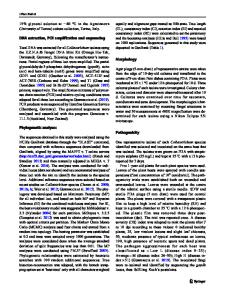Regeneration of Plants from Protoplasts of Coffea spp. (Coffee)
In many tropical countries, coffee is a crop of major economic importance, generating a total of 10–12 billion US dollars per year (Söndahl and Lauritis 1992). About 75% of the cultivated coffee is Coffea arabica, with the remaining 25% being C. canephora
- PDF / 1,446,022 Bytes
- 12 Pages / 439.37 x 666.142 pts Page_size
- 97 Downloads / 294 Views
SCHOPKE 1
1 Introduction In many tropical countries, coffee is a crop of major economic importance, generating a total of 10-12 billion US dollars per year (Sandahl and Lauritis 1992). About 75% of the cultivated coffee is Coffea arabica, with the remaining 25% being C. caneph ora, also known as Robusta coffee. Conventional coffee breeding has led to major improvements in yield and in resistance to pests and diseases. However, there are important obstacles that impede coffee improvement. The utilization of the more than 70 different members of the genus Coffea for the introduction of desirable traits into C. arabica is complicated by genetic barriers, since this is the only species of the genus that is autogamous and tetraploid. Another problem in coffee improvement is the long time required for breeding programs, a fact inherent in all woody crop plants. The application of biotechnological methods has the potential to overcome some of these difficulties. In numerous review articles on coffee tissue culture and biotechnology, the usefulness of protoplast techniques for coffee improvement has been discussed (Monaco et al. 1977; Sandahl and Sharp 1979; Sandahl et al. 1984; Baumann 1986; Sandahl 1989; Baumann and Neuenschwander 1990; Sandahl and Lauritis 1992; Menendez-Yuffa and Garcia 1996). Sondahl and Sharp (1979) describe some of the conceivable experiments with coffee protoplasts. Protoplast fusion would allow for the somatic hybridization of species that are recalcitrant to conventional breeding methods. Dihaploid protoplasts of C. arabica coming from anther or microspore culture could be fused with diploid, somatic protoplasts of other coffee species to obtain tetraploid hybrids. Protoplasts might also be manipulated by uptake of organelles. An example would be the transfer of cytoplasmic male sterility from C. eugenoides to C. arabica. Somaclonal variation in plants regenerated from protoplasts could provide a new source of genetic variability in cultivated C. arabica, which has a very narrow genetic base (Sybenga 1960) and which is known to be quite resistant to radiation and to chemical mutagens (Sandahl et al. 1984). Genetic transfor-
lILTABjORSTOM, The Scripps Research Institute, Division of Plant Biology - MRC7, 10666 North Torrey Pines Road, La Jolla, California 92037, USA
Biotechnology in Agriculture and Forestry, Vol. 38 Plant Protoplasts and Genetic Engineering VII (ed. by y'P.S. Bajaj) © Springer-Verlag Berlin Heidelberg 1996
22
C. Schiipke
mation by electroporation of coffee protoplasts with foreign DNA would be another important application of protoplast techniques. A number of papers have been published on various aspects of the isolation and culture of coffee protoplasts. Sandahl et al. (1980), Orozco and Schieder (1984), and Acuna and de Pena (1987) isolated protoplasts from leaf callus, leaves, and cell suspensions, respectively. In all cases, cell wall formation, cell division, and callus formation was observed. Sch6pke et al. (1988) and Sch6pke (1989) isolated protoplast from cell susp
Data Loading...











